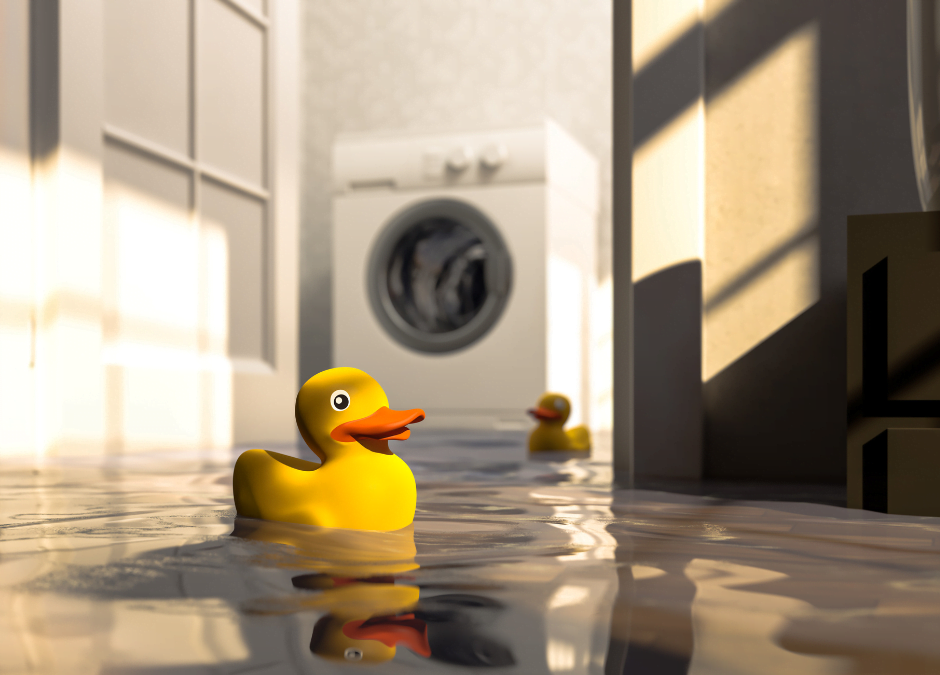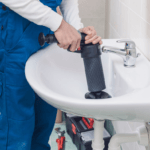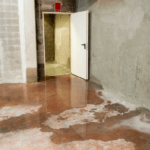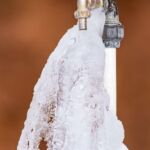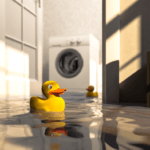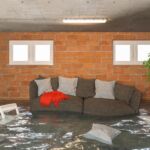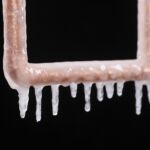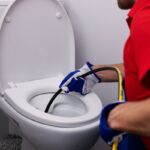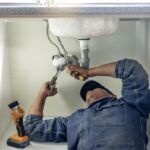Heavy rains can reveal leaks in your home’s foundation and lead to water seeping into the basement. Left unchecked, this water infiltration can cause extensive damage from flooding, mold growth, foundation issues, and even collapse. It’s crucial to act quickly to find and repair any sources of basement leaks.
In this comprehensive guide, we will cover:
- The most common causes of basement leaks during heavy rains
- How to thoroughly inspect your basement for signs of moisture or water damage
- Tips for locating specific points where water is entering the basement
- Steps for repairing basement wall and floor leaks
- Preventing leaks from basement plumbing fixtures like sump pumps or water heaters
- Upgrading your basement with flooding prevention systems
- Creating proper drainage and grading around your home
- Long-term waterproofing solutions for your foundation
Read on to learn everything you need to dry your basement after major storms.
Causes of Basement Leaks
Heavy rainfall and flooding can overload a home’s drainage systems and foundation walls, allowing water to seep into basements through cracks and openings.
The most common causes of basement flooding are gaps or cracks in the poured concrete or cinder block foundation walls. As mortar deteriorates between bricks or stones over time, it creates additional gaps for water intrusion. Loose wall ties can cause walls to bow inward, opening up cracks. Even small cracks or openings allow water to follow the path of least resistance downward.
Insufficient or improper exterior waterproofing materials also lead to leakage. Tree roots penetrating the foundation, poor exterior grading causing runoff toward the house, and lack of downspout extensions to divert roof runoff are other potential causes of flooding.
Clogged downspouts, gutters and drainage pipes create backups that send water toward the foundation. In some cases, a high local water table can flood upward into the basement through floors and walls. Window well flooding frequently seeps into window frames and walls during heavy rains.
Basement Plumbing Leaks
In addition to foundation seepage, basement plumbing fixtures are prone to leaks, especially if pipes or appliances are older. Potential problem areas include:
In addition to foundation seepage, basement plumbing fixtures are prone to leaking, especially in older homes. Water heater supply lines or tanks can burst or leak over time. Shutoff valves, supply pipes and drain traps under sinks and laundry tubs often start leaking.
Washing machine water supply lines are another common source as hoses age and connections loosen. Any kinks, cracks or loose fittings in water supply plumbing can develop into leaks. Toilets are also problematic with cracked tanks or bowls, loose bowl connections, and deteriorating wax ring seals.
As heavy rains overload home drainage, sump pumps may be unable to keep up, resulting in backups and flooding. Sewage ejector pumps can also fail or have clogged discharge lines that lead to flooding. Finally, clogged basement floor drains can create standing water backups.
Finding & Diagnosing Basement Leaks
Finding the exact location where water enters your basement is the first step toward solving basement flooding issues. Here are some tips for leak detection:
Begin by thoroughly inspecting your basement interior after heavy rains or sudden snow melts, resulting in standing water. Check for:
- Damp spots or water stains on walls, floors, or ceilings
- Puddles or droplets of water on the floor
- Darkened or warped wood on walls or floor joists
- Bubbling or warped paint, drywall, or flooring materials
- Efflorescence—a white powdery mineral deposit left behind as moisture evaporates
- Mold or mildew growth on walls, wood, or carpets
- A damp, musty odour
Isolate Affected Areas
Note any areas with moisture or leaks to isolate the section of the basement involved. This will narrow down where external water is coming from or which interior plumbing fixture could be leaking.
Inspect Exterior Foundation
Go outside and inspect your home’s entire foundation perimeter. Look closely for:
- Cracks wider than 1/4 inch
- Crumbling, missing, or deteriorating mortar
- Signs of water flow like dirt washing away
- Water droplets or damp concrete after rains
- White efflorescence deposits on exterior walls
- Moss or algae growth indicating chronic moisture
- Misaligned downspouts directing water toward the house
- Use a hose to simulate rainfall and observe if any sections leak.
Check Interior Plumbing
Thoroughly inspect basement plumbing lines and fixtures for moisture, rust, mineral deposits, or other signs of leaks:
- Examine water heater for rust and leaks at fittings, valves, or connections
- Inspect supply lines, drain pipes, and trap assemblies under sinks
- Check for toilet tank cracks and loose bowl connections
- Test sump pump operation and look for backup evidence
- Ensure floor drains and ejector pumps are clear of debris
- Assess washing machine hoses and valves
Professional Leak Assessment
For difficult-to-trace leaks or seepage, a licensed plumber has specialized tools to accurately identify problem areas:
- Moisture meters detect elevated moisture levels in walls or floors.
- Thermal imaging cameras detect temperature differences caused by moisture.
- Floodlights illuminate basement walls to expose cracks.
- Dye testing introduces coloured dye into plumbing to trace leaks.
- Pipe inspection cameras locate cracks or obstructions underground.
Repairing Basement Leaks
Once the sources of basement flooding have been identified, repairs can begin. The best repair method depends on the type and extent of damage:
Minor Foundation Cracks & Holes
For small cracks up to 1/4 inch wide in poured concrete or cinder block foundations, use a concrete crack sealant caulk labelled for basement foundations and masonry repair. Look for flexible polyurethane or epoxy-based sealants that won’t crack over time. Hydraulic cement products are also suitable for minor basement wall repairs.
Follow these steps:
- Using a wire brush, clean out any loose debris and dirt from the crack.
- Apply concrete sealer or patching compound according to product directions.
- Patch larger gaps or holes with hydraulic cement, working it firmly into the crevice.
- Allow full curing times before exposing repaired areas to moisture.
- Check exterior drainage to prevent water from pooling near basement walls.
- Major Foundation Cracks or Wall Damage
Severe Foundation Cracks & Holes
A professional foundation repair contractor is recommended for more severe foundation cracks wider than 1/4 inch, vertical cracks, wall sections moving inward, or severe spalling and crumbling. They have the specialized equipment and materials to provide structural repairs:
Carbon Fibre Reinforcement Strips:
Fibre-reinforced polymer (FRP) strips are applied over cracks with epoxy to bond concrete together. This structurally reinforces the wall and effectively repairs cracks up to 1 inch wide.
Wall Anchors:
Steel anchors are embedded within foundation walls using epoxy or concrete. The anchors are attached to adjustable steel brackets on the interior to push bowing walls back into the proper position.
Concrete Wall Patching:
Large holes and severely deteriorated areas of the foundation can be patched by injecting polyurethane foam behind the rebar, followed by applying a cementitious resurfacing compound.
Full Wall Replacement:
In cases of extreme damage, sections of foundation walls may need complete replacement. This requires stabilizing the structure, excavating to access the damaged section building forms, and pouring new reinforced concrete in lifts.
Waterproof Coatings & Membranes
In basements with chronic seepage through porous concrete or excessive humidity, waterproof coatings and membranes provide an extra moisture barrier:
Cementitious Coatings like Thoroseal® contain cement fillers and polymers that seal concrete pores against moisture penetration, both inward and outward. Two to three coats are applied with a brush or sprayer.
Bituminous Coatings and asphalt emulsions also repel water but may have strong odours during application that can linger afterward. Proper ventilation is needed.
Elastomeric Membranes like rubberized asphalt are rolled onto foundation walls to create a thick, flexible, waterproof barrier. These systems drain water down to perforated pipes at the base of walls.
Exterior Waterproofing Membranes can be applied to the outside of the foundation walls before backfilling. These adhesive sheets prevent moisture from contacting the foundation.
Fixing Basement Floors
In addition to walls, basement floors are susceptible to moisture damage and must be repaired and protected:
- Remove any water-logged carpeting, underlayment, wooden subflooring, and floor trim to expose the bare concrete floor. Allow floors to dry thoroughly.
- Repair cracks and deterioration in the concrete surface with hydraulic cement filler and resurfacing products.
- Etch and clean bare concrete floors before applying waterproofing sealant.
- Use an epoxy-based concrete floor sealant to waterproof floors against moisture penetration from underneath.
- Install an interior perimeter French drain and sump pump system to collect and remove seepage.
- Replace flooring only after concrete repairs and sealants have been applied and the floor is completely dry.
Ontario’s Trusted Plumbing Experts
Preventing and addressing plumbing issues requires diligent inspection, leak detection, and proper repairs. At Tap Tech, our licensed plumbers have over 25 years of experience diagnosing and resolving residential and commercial plumbing problems.
- 24/7 emergency services
- Scheduled appointments
- Professional plumbing services include drain cleaning, sewer repair, sump pump replacement, and leaky pipes.
Contact a certified plumber today from Tap Tech! Book Here or call 343-305-1172 for 5-star plumbing services and solutions.

